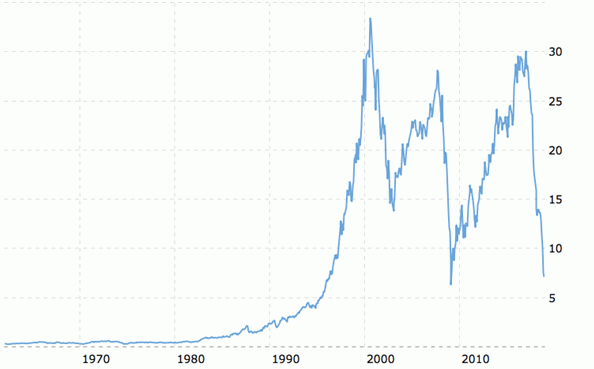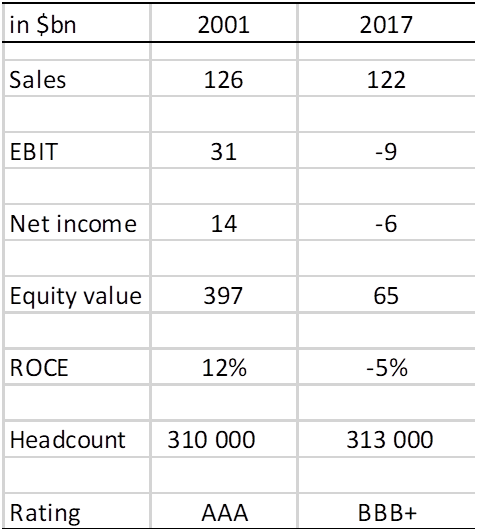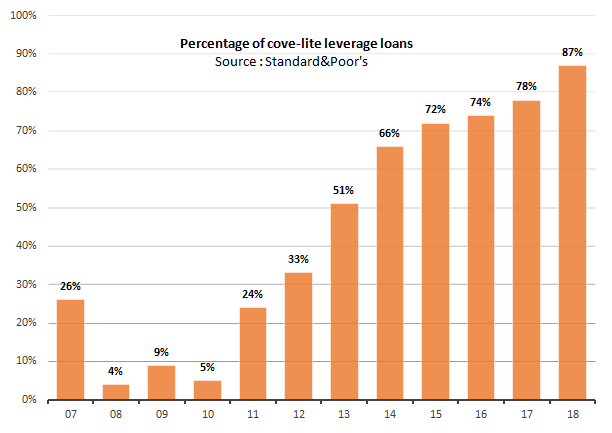Letter number 117 of December 2018
- TOPIC
- STATISTICS
- RESEARCH
- QUESTIONS & COMMENTS
- NEW
News : The tribulations of General Electric or conglomerates coming around again
The choice of businesses: it appears that since the 2010s, resource allocation has not been as felicitous as in the past
New conglomerates are currently emerging – Amazon, Alphabet, Tesla, Dyson, Alibaba, etc.
Statistics : Percentage of cov-lite leveraged loans
A cov-lite leveraged loan is a leverage loan with very light covenants or no covenants at all.
Their percentage among total leveraged loans is a clear indication of risk appetite for bankers and debt investors. It has never been so high since 2007.
It does not necessarily mean that another collapse in LBO financing is in the offing, but that it is a borrower market where lenders are chasing too few deals given the amount they want to invest in the class of assets. Hence borrowers are able to negotiate good deals for them with a low level of constraints.
If things start to unravel, lenders will not have the power to get fees and higher spreads to compensate them for solvency deterioration; nor to seat at the table to discuss financial reorganisation with borrowers. You can’t have your cake and eat it too!
Research : Environment, stakeholders and financial performance: complex relationships
With Simon Gueguen, Senior Lecturer at the University of Cergy-Pontoise
Taking all of a firm’s multiple interests into account is always a complex matter. Stakeholder theory, which arose in the 1980s, holds that the development and long-term survival of a firm depends on the interests of all of its stakeholders (employees, customers, suppliers, public authorities, the full range of its investors, etc.) being taken into account. This theory runs contrary to the shareholder-based vision, according to which the interests of shareholders prevail over all others. Many studies have been carried out over the years to determine whether these two visions are complementary or conflictual, i.e., whether the explicit factoring in of the interests of all stakeholders benefits or penalises shareholders.
Three researchers[1] decided to include environmental concerns into the equation. The idea is as follows: if this concern is shared by the firm’s various stakeholders, then factoring in the environment can help to resolve the conflict between shareholders and other stakeholders. The study covers two strategically chosen economic sectors: food and beverages on the one hand and household and personal products on the other. These two sectors are large consumers of natural resources and the public is particularly attentive to their impact on the environment.
This article is very solid technically. Working with experts and management, Brulhart et alii came up with a new measure, a firm’s “stakeholder orientation”. In the same way, they constructed an “environmental proactivity” index whose aim is to capture any affirmation of environmental awareness as well as environmental initiatives taken by management. Electronic questionnaires were sent to managers (responsible for environmental issues) at French companies in the two sectors concerned in 2009 and 2010.
The empirical study involved analysing the links between three variables: the two variables that were constructed for the study and a financial performance variable. For the latter, Brulhart et alii use the earnings to sales ratio (productivity) or the earnings to amount invested ratio (profitability) alternatively. Their first results show a weak and slightly negative link between stakeholder orientation and financial performance. In the sample studied, it would thus appear that explicitly taking all stakeholders into account is detrimental to the interests of shareholders. However, environmental proactivity has a positive impact on financial performance. More particularly, and this is probably the central result of the article, at environmentally proactive firms, the link between stakeholder orientation and financial performance becomes positive. In other words, being environmentally proactive leads to a reconciliation of the interests of other stakeholders with those of shareholders.
Brulhart et alii thus conclude that there is a complex complementary fit between environment, stakeholders and financial performance. The results are probably determined by the sample studied but this article does offer an interesting explanation for the contradictory results that have been obtained until now in this area. The interests of stakeholders are diverse and contradictory and the introduction of good practices in terms of the environment and sustainability could help to satisfy some of these interests without penalising financial performance.
[1] F. BRULHART, S. GHERRA and B. V. QUELIN (2017), “Do stakeholder orientation and environmental proactivity impact firm profitability?”, Journal of Business Ethics, pages 1 to 22.
Q&A : A few short questions and their answers
In an income statement by function can we say that the costs of sales correspond to the sum of all variable costs?
No, unfortunately, since costs of sales (COGS) also include fixed costs such as the amortization expense of production machinery. In addition, all variable costs are not in the COGS since the bonuses paid to salesmen are part of the selling and marketing costs whereas they are variable costs since related to the sales.
For more details, see Chapter 3 of Vernimmen.
Why in a construction company inventories are low and how to track the work-in-progress line that is important?
For a construction company, inventories are often low because it is supplied daily by its dealer in building materials, and it is the one which carries the bulk of inventories in this sector.
It is necessary to monitor over time the evolution of the item Work in progress in relation to the item Customer advances; and when Work in Progress grows faster than or exceeds the Customer Advances line, beware. This is either a sign of poor management, because in this sector customers are asked to pay as work progresses and well-managed companies always charge customers a little in advance of the completion of the work. Or the sign of a fraud if losses on a construction work are hidden by an overstatement of Work in progress, which do not forget, are nothing from an accounting point of view but costs that have been taken out of the P&L account to be written into an asset on the balance sheet, which improves margins in the P&L.
Should we take financial fixed assets in the computation of operating assets?
In the face of financial fixed assets, it is necessary to sort out those which are used for the activity (for example a deposit for a rent of stores, or a non-consolidated participation in its distributor in Saudi Arabia) and those which are non-operating assets (such as L'Oréal's 9% stake in Sanofi) The former is included in the operating asset, not the latter, for the calculation of the ROCE or for the calculation of the enterprise value. But normally, except perhaps for certain large groups, the second case is quite rare.
Non-operating financial fixed assets are then to be taken in reduction of the bank and financial debt when you move from enterprise value to equity value.
What is the difference between the net present value and the present value?
Let's take an example. Someone promises to pay you 110 in a year if you pay him 100 today.
With an interest rate of 10%, the present value of this promise is 110 / (1 + 10%) = 100. The NET present value of this promise is equal to the present value of its future cash flows, 100, MINUS the price you pay today for this promise, 100, here 0.
This net present value simply means that this investment (paying 100 today to receive 110 in one year) will bring you exactly the required rate of return, that is 10%. You will not make a bad deal or a good deal, you will simply do a decent deal. If you now want a rate of return of 5%, the promise to receive 100 in a year is worth for you, at 5%, 110 / 1.05 = 104.8. It's its present value.
If you can buy this promise as previously for 100, its NET present value is 104.8 - 100 = 4.8. This positive net present value shows that you will make a good deal for you because you pay 4.8 less than you could, to make an investment that earns you the rate of return you want, 5% in this example. You will therefore enrich yourself of 4.8. This is also what the net present value measures, your enrichment if everything goes as planned.
For more details, see Chapter 16 of the Vernimmen.
Could you tell me if the long-term growth rate may be nil or negative in the discounted cash flow formula?
There is no reason why it cannot be negative in some sectors or for some companies, because if world growth is 4%, some companies grow at 20% or 30%, others necessarily have much lower growth rates, including negative ones. For example, at the moment, the magazine press in Europe: decrease of the diffusion and fall of the advertising receipts.
Why is inflation not a corrective factor of free cash flows for a DCF valuation?
To the extent that the cost of capital is equal to a risk-free rate plus a risk premium, and the risk-free rate is a market interest rate, it includes a premium for expected inflation.
Therefore, there is no need to deflate free cash flow for inflation. If you do it, i.e. if you take free cash flow in real terms, then you would have to also, by homogeneity, take a cost of capital deflated by inflation, by dividing (1 + your cost of capital) by (1 + anticipated Inflation Rate) and then deduct 1.
If you calculate the cost of capital by an indirect approach by computing it as the weighted average of cost of equity and of cost of the debt, things would not be different because you would also use market data that includes an inflation expectation.
New : Comments posted on Facebook
Regularly on the Vernimmen.com Facebook page[1] we publish comments on financial news that we deem to be of interest. Here are some of the comments published over the last month.
Index funds with management costs of 0%?
This was launched during the summer by Fidelity, known for its active management and not its passive management skills, to limit its losses of assets under management moving to index funds and ETFs. The success of this first product on the market with management fees of 0% is undeniable: its US equity fund and its non-US equity fund have raised so far more than $2bn in 6 months, a quarter of which for the international fund and 3/4 for the US equity fund, illustrating the domestic bias of investors.
It's definitely two loss-leaders products for Fidelity. It is necessary to open an account at Fidelity to be able to subscribe, which allows the asset manager to offer other products more remunerative for it to its new customers, or de-incentives the current ones from moving to the competition. In addition to the volume effect necessary to reduce the costs invoiced to zero, Fidelity relies on indices that it has developed, which avoids having to pay royalties to the owners of indices like Dow Jones or MSCI; and practices securities lending on the shares held by these funds. Securities lending allows Fidelity to receive fees from short-sellers who needs to borrow shares to short-sell them. In a nutshell, it allows other investors to bet down securities prices held by Fidelity on behalf of its customers. . . This is the price to pay for having zero fees. As we say in the United States, there is no free lunch.
Maersk and Danske Bank
Denmark is home to the largest group of container ships in the world, Maersk, founded by the family of the same name, which is also the largest company in this country of 6 million inhabitants.
Since 1928, the Maersk family has been the largest shareholder (21%) of what has become Denmark's largest bank, Danske Bank. Not stupid indeed to carry out a wealth diversification whereas Maersk is in a very cyclical sector, nor to have a foot in a bank which knows you well to help finance heavy investments, a container carrier being worth a little more than a scooter.
The Estonian subsidiary of Danske Bank, visibly poorly controlled by its parent company, would have in nine years whitewashed several tens of billions of euros (some even speak of €200bn) from countries of the former USSR.
The revelation of this scandal led Danske Bank shareholders to separate from its managing director in September, and most recently from the bank's president. The representative of the Maersk family said: "We are a large shareholder and we have obligations and it’s only fair there are expectations on us. "
Centuries away, we can echo Hamlet that in the Kingdom of Denmark, everything is not rotten, as long as there are shareholders aware of their responsibilities.
.
Towards an evolution of notification thresholds for M&A transactions?
Generally speaking, the thresholds beyond which acquisitions must be notified to the antitrust authorities for approval are expressed in terms of turnover: €5bn at the European level, $84.4m in the USA, €150m in France, etc. As an exception, Spain has a threshold in terms of cumulative market shares (25%). Germany has just added a threshold expressed in equity value (and not in enterprise value) of €500m and Austria has done the same (€300m). In 2016, Europe decided not to change its position. France is currently reflecting on the subject after having launched two public consultations on this topic.
The reason is obvious: some companies can be highly valued without making a significant turnover that puts them below the concentration thresholds: in the digital sector of course, but also in pharmaceutical research, automotive parts, etc.
Another trend is to subject to the control of antitrust authorities not only the change of control, but also the acquisition of significant minority stakes. For example, in Germany, for equity investments giving more than 25% of the capital of a company.



